Lobularia Maritima: [Cultivation, Care, Pests and Diseases]
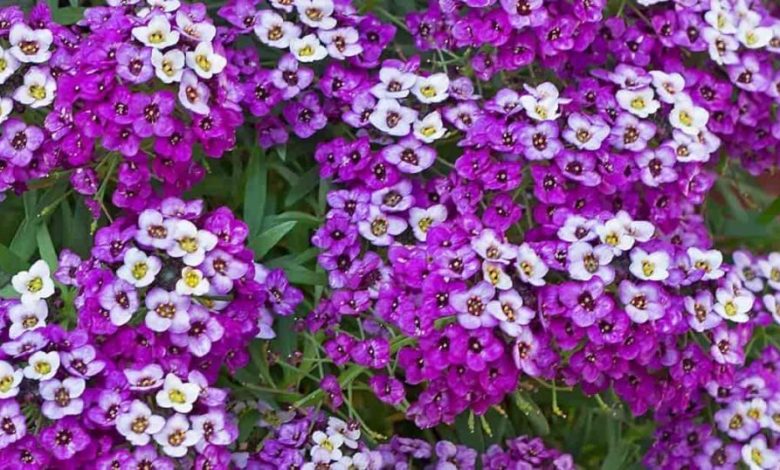
Important points when sowing Maritime Lobularia
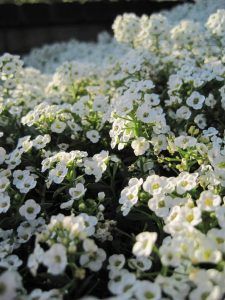 When? Except for summer and early fall, this plant can be grown at any time of the year, although the best of all is spring.
When? Except for summer and early fall, this plant can be grown at any time of the year, although the best of all is spring.- Where? It grows anywhere, near or far from the sea, in temperate, hot or cold regions of the planet, although they are clearly Mediterranean. They grow well in the garden and in large pots.
- How do we prepare the land? A good substrate or bone meal is the most advisable. Or simply, fertile garden soil, good drainage and neutral or alkaline pH.
- How do we sow? It is grown from seeds that germinate very quickly, with the help of pollinating insects attracted by its strong aroma of honey, and through cuttings, preferably in spring.
- How do we pay? If kept in a pot, fertilize with liquid fertilizer once a month, applying only to the base.
- When do they bloom? Its smallaromatic white flowers can last a long time, from the winter to the following summer if it is in optimal conditions of humidity, light
- Ideal temperature? It ranges between 18ºC to 22ºC. It supports low temperatures. Extreme heat can dehydrate it if it does not receive enough water.
- How do we water? Watering is key, but it should not be overdone. It needs a lot of hydration. 2-3 times a week in summer and 1 every 8 days in winter.
- Diseases and pests? It is very healthy, although it can be attacked by aphids. It is used to control pests in crops, because its strong aroma attracts insects.
What is Lobularia maritime?
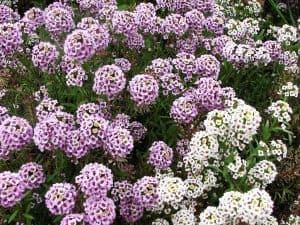 The Maritime Lobularia, Alysumm maritimun, or Sea Alder is an annual or perennial plant, belonging to the brisacaceae or cruciferous family.
The Maritime Lobularia, Alysumm maritimun, or Sea Alder is an annual or perennial plant, belonging to the brisacaceae or cruciferous family.
It bears the name of Lobularia for the lobule aspect that its fruit has and maritime for its original growth near the sea.
It reaches a minimum of 10 and a maximum of about 25 wide, by 30 centimeters high. It is expansive growth.
It is characterized by the development of multiple inflorescences and small white, pink or violet flowers of about 6 millimeters in diameter, which have 4 green sepals and 4 cross-shaped petals, capable of flooding the entire plant and emitting a singular aroma with honey smell
At its base, it has a light grass containing small linear or lanceolate leaves and a typical whitish color with a hairy texture, with hairs that range between 1 to 4 centimeters in length and approximately 5 millimeters in diameter, with entire edges.
It has an active presence in the Mediterranean region, in areas where frost does not occur and can also be seen in the Canary Islands and the Azores.
Where should we plant it?
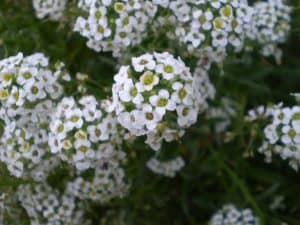 It is easily obtained in coastal and tropical regions of the entire world, although as we have already said it is clearly Mediterranean.
It is easily obtained in coastal and tropical regions of the entire world, although as we have already said it is clearly Mediterranean.
It also has a presence in the mountainous massif of the Spanish Sierra Nevada, in the upper parts of the Iberian Peninsula, belonging to the Betic Cordilleras, from the province of Granada to its easternmost part, in the province of Almería.
As it has great covering power, gardeners and botanists have managed to make it adapt to practically any terrain with ideal conditions.
It has various applications as an ornamental plant in gardening, since its seeds germinate very quickly and because it handles very well due to its low height.
Some species even withstand prolonged droughts and even develop in cracks, walls and fissures in the cement in many tropical countries, far from maritime regions.
When should Lobularia maritime be cultivated?
It is a plant whose cultivation works very well if it occurs in the spring, without requiring much care, although it requires a delicate cleaning or removal of dead flowers so that it blooms again with force.
There are expert gardeners who recommend planting this floral beauty all year round, except for summer and early fall. It is very resistant to the sun, it can also live in partial shade and there are varieties, the dark ones, that are very tolerant of low temperatures.
How do we prepare the land?
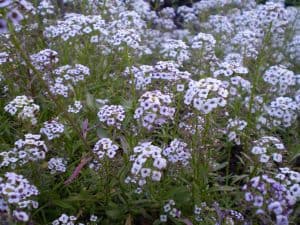 You need to use prepared soils with a neutral or alkaline pH. Its underground body is quite vigorous, in porous or clayey spaces, which allow it to achieve greater expansion.
You need to use prepared soils with a neutral or alkaline pH. Its underground body is quite vigorous, in porous or clayey spaces, which allow it to achieve greater expansion.
Its flowering, in well-drained, nourished soils, can last from winter to the following summer, because they last quite a long time, since its hermaphroditic flowers are also very resistant and cover all the foliage.
Moreover, in countries with a temperate climate where it is also called Canastilla or Panalillo, it can flower all year round, as long as it does so on permeable soil, with constant irrigation and a good pruning of branches and dead flowers.
How to plant a Maritime Lobularia step by step?
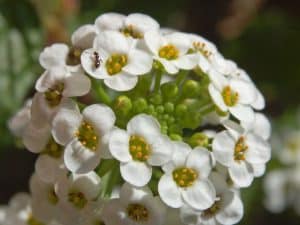 It is a very noble plant, with an average life span of 2 to 3 years, but with a great ability to multiply on its own. Lobularia maritime can be seen everywhere in the garden.
It is a very noble plant, with an average life span of 2 to 3 years, but with a great ability to multiply on its own. Lobularia maritime can be seen everywhere in the garden.
As long as it is sunny and receives the generous visit of insects, such as bees, who, attracted by the strong smell of honey from its hermaphroditic flowers, favor optimum pollination, which multiplies them when seeds fall that germinate quickly.
A simple method to keep it forever in our garden is to reproduce it by seed or cuttings. Let’s see how to easily multiply them.
Reproduction by seeds
- Buy a packet of Lobularia maritime seeds. It is easy to obtain them in the nursery you trust.
- Place a wide-mouth plastic container or seedbed on a counter, several tablespoons of substrate or bone meal and water the small seeds, which will immediately be mixed into the soil with the help of a slight movement of the hands.
- Generously water the soil with 2 or 3 sprays of rainwater and keep it moist at all times, until in about 15 to 20 days they will begin to germinate without major difficulties, showing little plants or shoots that must be cared for until they become new tender plants.
Reproduction by cuttings or shoots
- Buy a large, large-diameter pot. We will fill it with a good substrate or fertile soil halfway very moist, leaving a measure of about 5 centimeters upwards, that is, it will not be completely filled with soil, halfway through the container will be more than enough.
- Some very live branches of a mature plant will be taken, all the flowers will be removed to prevent them from consuming a lot of energy and shoots will be separated from stems that will be sown one by one, with a certain separation, on the surface of the substrate, gently sinking them with the help of of the fingertips.
- Guarantee permanent environmental humidity conditions that are maintained at 100%, to prevent the leaves of small shoots or cuttings from dehydrating and encourage the emergence of roots. This is achieved by wrapping the entire container, from top to bottom, with a plastic film that does not completely cover the surface, it must be allowed to breathe to prevent rotting.
- Take it to a place with good light, not so intense, and water it daily, taking care to avoid ponding. The pot must have a good drainage system so that in a short time we have new plants.
- If the new plant is kept in a pot, it is convenient to fertilize it once a month, placing the product on the base to prevent it from burning.
What care does the Lobularia maritime need?
- It is a highly resistant plant, tolerant of dry climates, but prefers to live in humid environments.
- It is essential to keep it in a place where it receives full sunlight, because it stimulates its growth.
- It feels best in temperatures that encompass lows that can range from -12ºC to -17ºC. So, it supports icy winters and constant sea breezes, without this slowing down its growth and flowering.
- Fertile and loose soils, or clayey, all with good drainage and with a neutral or alkaline pH, are very suitable for this beautiful plant.
- It is very important to avoid puddles when irrigating with water. Therefore, it will be enough to water 2 to 3 times a week in the summer and in winter just 1 time every 8 days, in order to achieve a balance in the issue of environmental humidity, together with other determining factors such as sun exposure., period of the year and temperature.
What pests and diseases attack Lobularia maritime?
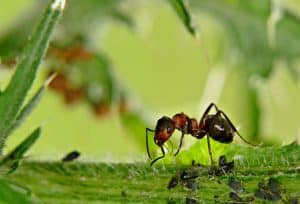 It is very rare for it to get sick, but it can be attacked by aphids, which are combated with soapy sprays prepared with a solution of powdered detergent dissolved in water, as well as worms that can appear sporadically and must be removed after constant inspection of the foliage.
It is very rare for it to get sick, but it can be attacked by aphids, which are combated with soapy sprays prepared with a solution of powdered detergent dissolved in water, as well as worms that can appear sporadically and must be removed after constant inspection of the foliage.
It is a generous plant, it is always healthy and the version with white flowers is the most aromatic, so many bees will always be on top of them looking to suck the nectar from their flowers, causing the tiny seeds to fall to the ground to germinate.
Due to its great capacity to attract insects, it is used to control pests that attack vegetable crops, because its intense smell diverts them towards its tiny flower, eager to multiply.
An extreme pruning should only be carried out when the insect attack is very great, so it is essential to prune the plant by half and then apply a good fertilizer of organic origin that helps it recover strength with the added nutrients.


![Photo of Compost: [Complete Guide to make your own Compost]](https://www.complete-gardening.com/wp-content/uploads/2022/08/compost-complete-guide-to-make-your-own-compost-390x220.jpg)
![Photo of White Flowers: [Complete List of 16 Plants + Images]](https://www.complete-gardening.com/wp-content/uploads/2022/08/white-flowers-complete-list-of-16-plants-images-390x220.jpg)